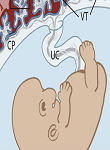|
|
|
Editorial: Mechanisms Safeguarding the Trophoblast Multipotent State
|
|
|
|
|
|
|
|
|
|

|
|
|
|
Rajesh Kumar, PhD.
|
|
|
|
Dana-Farber Cancer Research Institute
|
|
DFCI, Boston, Massachusetts, 02140 USA
|
|
rajesh_kumar@dfci.harvard.edu
|
|
|
|
|
|
|
|
|
|

|
|
Approximately one-third of the human pregnancies have placenta-related defects including recurrent miscarriage, preeclampsia, fetal growth restriction, and uterine inflammation (Young, Levine et al. 2010, Giakoumopoulos and Golos 2013, James, Srinivasan et al. 2014). Hence it is very important to understand the pathophysiology of placental development. Pregnancy is a unique situation in which the mother and the hemi allogeneic fetus cordially coexist. Several fetal, maternal and placental mechanisms function in concert to protect the fetus from immunological recognition and rejection (PrabhuDas, Bonney et al. 2015). The placenta provides the interface for gas and nutrient exchange between the mother and the fetus and hence proper placental function is critical for healthy pregnancy. However, despite its role in sustaining pregnancy, the trophoblast stem and progenitor cells hierarchy and the underlying molecular mechanisms responsible for the development of the placenta are not well described.
|
|
|
|
|
|
|
|

|
|